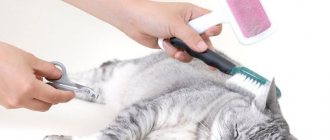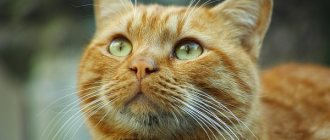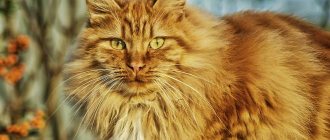Often, owners of long-haired pets are faced with such an unpleasant phenomenon as mats in their cats. Fluffy mustaches are distinguished by their affectionate nature, peaceful disposition and delight the human eye with a beautiful fur coat that requires special care. The long and fluffy fur of pets needs to be protected and cherished, combed regularly, bathed with a special shampoo, and if necessary, use cat spray. Otherwise, the hair falls off, it becomes impossible to comb out the dense icicles, and all that remains is to trim the cat, which will immediately affect the pet’s well-being and appearance.
What is it: how to recognize pellets?
In the coat of cats, a regeneration process is constantly taking place; the coat has the ability to renew itself and get rid of old hairs, which must be urgently removed by combing. If this is not done, the fallen hairs become entangled with the growing ones, tangles appear that are almost impossible to comb out, since such a procedure will cause severe physical pain to the pet. In this case, the pet’s owners will have no choice but to cut out the matted fur. As a rule, matting of pile with the formation of dense clumps in long-haired cats is observed in the neck, “pants”, tail, but can often be found on the back, stomach and the entire body of the animal.
A short-haired cat is much less likely to experience pellets in its fur. But if the pet is not provided with normal care, the cat is not bathed, its coat becomes dirty in the same way, the hair rolls off, tangles appear, which are no easier to remove than in the Persian.
What are mats?
Mats are dense clumps of matted old wool. Young cats lick themselves constantly. Thus, they remove old fallen hairs, preventing the appearance of tangles.
© shutterstock
Old or sick cats sometimes cannot maintain such hygiene. The fur begins to weave, tangle, and dense clumps appear. However, even young cats are not always able to prevent the appearance of mats.
Causes: where do they come from?
Breeds with long and lush coats require regular grooming.
It is easier to protect your pet from skin problems than to treat serious consequences later, because when the fur becomes tangled, it is not only a spoiled appearance of the cat, but there are also many reasons that lead to serious illnesses for the pet. Sometimes a long-haired cat is simply not able to take care of the condition of its lush hair on its own, so the owner is obliged to help the pet in this difficult matter by providing regular care.
Causes of tangles in short-haired and long-haired cats:
- Poor nutrition. Poorly selected food causes an imbalance in the gastrointestinal tract of animals, which leads to skin problems and dandruff, which directly affects the condition of the coat.
- Poorly organized bathing. Many owners bathe cats with cosmetic shampoos, not realizing that preparations with specific fragrances are dangerous for the cat’s fragile coat.
- Pollution factor. Matted fur may indicate the presence of dirt on the animal's coat, which the mustache cannot remove on its own.
- Presence of parasites. The first sign that fleas or lice have appeared in a cat's hair is dull, brittle hair that has rolled up and formed tight tangles. Simply cutting off the pellets will not work; treatment is already needed.
Causes of dandruff in cats
The causes of dandruff can be different. They are usually divided into internal and external.
External reasons
- Dry air in a room is harmful not only to people. In cats, it leads to dryness of the skin, which will certainly manifest itself in the form of dry seborrhea. Temperature changes have the same negative impact. If the room becomes too hot, the subcutaneous glands that secrete fat begin to work too intensely, and this leads to oily seborrhea.
Dry air and elevated room temperatures lead to dry skin
- If your cat is exposed to the sun for a long time, it will cause sunburn, as a result of which the top layer of skin will begin to rapidly die.
If your cat is a sunbath lover, he can easily get sunburned.
- Poor hygiene. Over-grooming your pet is just as bad as not grooming it at all. Let me remind you that you should not bathe your cat often. The procedure can be performed no more than once every 3–4 months. You need to be extremely careful when using cosmetics for animals. The wrong shampoo will cause allergies. It is best if at the end of the bath you rinse the animal with a decoction of nettle, calendula or burdock root.
Bathing too often with the wrong shampoo is the cause of dandruff.
- The appearance of dandruff can also be caused by a lack of hygiene in the room where the cat lives. Parasites that accompany unsanitary conditions disrupt the functioning of the sebaceous glands. As a result, the unfortunate animal suffers greatly not only from bites, but also from the unbearable itching of irritated and reddened skin.
Unsanitary living conditions contribute to the rapid infestation of cats by insects
- Fungal infection. Pathogenic microscopic organisms lead to diseases, the most common manifestations of which are dandruff, bald areas of skin, and wounds. Signs of a fungal infection may include black skin peeling.
Signs of a fungal infection may include black skin peeling.
Internal reasons
- Obesity. Loving your pet does not mean feeding it treats and pouring food on demand. This leads to excess weight, which means your cat will become lazy and clumsy. And for such cats it is quite problematic to put themselves in order. In the absence of proper care, keratinized particles will accumulate in hard-to-reach places and cause concern.
Excess weight in a cat is not a reason to be touched
- Eating the wrong foods often triggers an allergic reaction. Too many carbohydrates and lack of minerals, Omega-3 fatty acids and vitamins (especially A and B) or the inclusion of a new product in the diet can cause skin problems.
Poor diet leads to allergies
- Diabetes. This is a very serious disease that is very difficult to detect in the early stages. The course of the disease further manifests itself in the fact that the cat begins to experience extreme thirst, refuses to eat, loses weight, and often urinates. The coat loses its shine and dandruff appears on the skin. An advanced disease often leads to the loss of a pet.
Diabetes mellitus is a dangerous disease for cats
- The formation of dandruff can be a consequence of stress, a cold or other inflammatory processes, as a result of which the cat becomes lethargic, loses appetite and stops grooming itself.
Stress is another possible cause of seborrhea.
- Dehydration. Fluid makes up almost 80% of a cat's body. And, despite the fact that most cute fluffies suffer from aquaphobia, water plays a vital role in the life of an animal. Therefore, a bowl of clean water should always be in a place accessible to the cat, especially in hot weather, when the need for drinking increases or if the animal’s diet consists of dry food. Dehydration can lead to dry skin and, as a result, dandruff.
Do not lead to a situation that threatens the cat with dehydration
- Hormonal disbalance. A problem with the thyroid gland can lead to disruption of the sebaceous glands. The result is the formation of dandruff.
How to get rid of it: quick help for your pet
If you feel the smallest hairballs, they should be removed immediately.
If the cat is provided with regular care and the animal's thick hair is regularly combed, then it is not difficult to detect a dense mat. Even with simple stroking, a dense formation is felt under the hand among the smooth coat. Removing clumps is an unpleasant procedure for both the cat and the pet owner. However, the mandatory nature of the process is not discussed, because if you do not untangle the tangled fur in time and do not rid your pet of annoying lumps, then an unplanned haircut for the cat is guaranteed.
You can quickly remove mats from your cat at home using the following diagram:
- If a lump has formed on a short-haired cat, a water procedure and thorough combing will be enough. It is possible that matted wool that has become matted will not need to be trimmed.
- If the pellet has been matted recently and does not yet have a dense structure, it can be carefully disassembled with your fingers without causing pain to the cat, the villi will be smoothed out and there will be no need to cut off the area of fur.
- If strong tangles are located throughout the animal’s body, you can try to preserve at least part of the affected cover. You should cut the seals along the hair growth, cut off the most hopeless areas and comb the thick pile with a stiff cat brush. Having treated one area of the body, you should comb the cat’s fur to the other side and repeat the manipulation.
When your beloved cat actively resists such procedures, and there are a lot of tangles in the fur, it is better to cut out the seals with children's scissors with rounded edges. In this case, the animal can break out and scratch, so the owner will need the help of third parties. If the mission turns out to be impossible, you should seek help from professionals at a grooming salon.
Dandruff is a common problem in cats
Despite the fact that cats are very clean animals, dandruff is quite common among them. This phenomenon may be completely natural, since animals constantly renew their skin. A small amount of dead skin flakes should not cause much concern; cats can easily cope with this problem on their own. But excessive formation of dandruff can be a signal to go to the veterinary hospital, as it indicates a pathology or disruption in the functioning of the body.
When pets get into trouble, our task is to help the purr
What is dandruff
First, let's figure out what cat skin is. It consists of 3 layers:
- epithelial is the top layer in contact with the environment;
- connective tissue dermis - the next layer in which hair follicles, skin glands, blood vessels and nerves are located;
- subcutaneous layer consisting of loose connective tissue, including fat cells.
The top layer performs a protective function and therefore requires constant updating. The keratinized particles of skin, saturated with fat, peel off from time to time in the form of scales in a small amount. These small, loose white flakes are dandruff. This is normal. But if the peeling process intensifies, the top layer ceases to perform a protective function. This should alert cat owners.
Small peeling areas of skin are normal in a healthy cat, which a clean animal can deal with on its own
Dandruff forms over the entire surface of the animal's skin, but the greatest localization is most often noticed in the back area near the tail and behind the ears. A large accumulation of dead skin flakes causes a lot of anxiety in a pet. You've probably noticed how a cat diligently and nervously begins to lick an itchy spot, sometimes trying to scratch it to feel relief. Excessive exposure can even cause wounds to form on the skin.
Excessive accumulation of dead scales on the skin is evidence of a malfunction in the cat’s body.
Signs of a problem
If you begin to notice the following signs, then your pet has a problem:
- a large accumulation of skin scales, mostly large, is noticeable on the surface of the fur;
- the cat constantly licks the problem area;
- the coat looks untidy;
- itching causes a constant desire to scratch the affected area;
- in advanced cases, hair loss and wound formation are possible.
Nervous scratching can cause wounds
Types of dandruff and places of its localization
Dandruff or, more correctly, seborrhea appears in cats regardless of age, gender or breed. Depending on the causes, dandruff can be dry or oily and accumulate in different parts of the animal’s body.
- Dry dandruff is tiny particles of epidermis that cover the cat's entire body. If you stroke your pet against the grain, the particles easily separate and swirl around like a snowball. Signs of dry seborrhea are:
- insufficient function of the sebaceous glands;
- dry skin and increased flaking;
- keratinization of the epidermis.
Dry seborrhea in a cat is the smallest particles of keratinized skin
- Oily dandruff is usually localized behind the ears or on the back in the tail area. If you scratch your pet in this place, a white or light beige coating will remain under the nails. The coat in such places looks greasy and unkempt. Signs of oily seborrhea:
- increased activity of the sebaceous glands;
- dead scales accumulate under the fur in a dense layer;
- wool gets dirty very quickly.
With oily seborrhea, the hair looks very untidy
It is easiest to detect dandruff in black cats.
Why they are dangerous: hidden dangers for animals
Hairballs that seem harmless at first glance can cause significant harm to your beloved pet. The games of kittens and adults are very exciting; while playing, a cat can get caught in a tangle on a foreign object and injure itself with a thoughtless jerk. Such a moment will be forever imprinted in the mustache’s memory and the animal will no longer allow you to touch its fur. If we delve deeper into the topic, tangles are not a disease and do not pose a direct risk to the life of the animal. However, the reasons that encourage you to remove and deal with unkempt fur are quite valid:
- ugly looking cat;
- discomfort for the animal;
- formation of dandruff and diaper rash on the skin;
- the possibility of wounds and ulcers;
- a favorable environment for the development of parasites, fungi and harmful microorganisms.
Reasons for the formation of tangles
The main reasons for the appearance of mats:
- Lack of vitamins and minerals in the body due to an unbalanced diet;
- Breed predisposition;
- Insufficient coat care;
- Heavy contamination;
- Seasonal shedding;
- Disease.
It is impossible to say unequivocally why tangles appear, each case is individual, but one thing is definitely clear - you need to get rid of them - the sooner the better.
Reference! If your domestic cat constantly has clumps of matted hair, you need to reconsider the animal's diet or show your pet to a veterinarian.
The most susceptible to the formation of tangles are “plush” cats, with very soft fur and a thick “cotton” undercoat.
Prevention measures: how to avoid?
It is much easier to protect your beloved animal from possible problems with its fur than to later eliminate problems in its history. Moreover, precautionary rules must be observed from the very birth of the kitten; newborn long-haired pets are also at risk of developing mats. To prevent the hair from matting and the cat to have a beautiful silky coat, you need to follow a few simple rules of cat hygiene:
- Brush your cat regularly, at least 3 times a week, preferably every day. Use a hard brush with thick teeth.
- Buy a special anti-matt product, perhaps a softening shampoo or balm for bathing cats.
- When bathing, do not fluff the hair, apply shampoo with light stroking movements, also foam and rinse the animal from the product.
- It is recommended to dry animals with a hair dryer, this helps prevent the formation of tight lumps due to improper drying.
The functionality of the gastrointestinal tract directly affects the condition of hair in cats. If the fur sticks together, has not grown back since the last haircut, and the entire fur coat is covered in ugly icicles, this is an alarming signal about a violation of the internal organs. First of all, your pet should be shown to a veterinarian to rule out a possible disease. Cat food should be of high quality, preferably with protein supplements. It won't hurt to pamper your pet with vitamins and minerals.
How to remove tangles
What to do if your cat has mats? They must be removed immediately upon discovery. Check the abdominal area around the paws, armpits and neck more often. Hairballs appear there first due to the animal's movements.
If the tangles have appeared recently, you can untangle them with your hands. Each lump is separated by hairs; you can simply stir it with your fingers. Then walk with a comb or a special brush from the back to the stomach and paws - from top to bottom.
When the tangles have already started and do not respond to this method, then the presence of a second person during the procedure is desirable. While one is engaged in removing lumps, the other will hold and calm the animal.
If it is impossible to comb the tangles, they are cut off. This must be done very carefully. First, the lump is cut with a knife or scissors, but so as not to damage the skin. Then you need to slowly untangle the fur with your hands and comb it out. This method will help preserve as much of your luxurious fur coat as possible.
When a cat has tangles, you can use a special device - a tangle cutter. This is a comb with sharp blades. Using a mat cutter helps to significantly reduce damage to an animal's coat.
However, fur that has matted into large clumps can only be removed with a haircut or in a grooming salon. For the procedure, scissors with not very sharp tips or a machine with a nozzle of 2 mm are used. When removing mats, the animal must be held firmly. The skin should be taut when cutting. The head, tail and paws are cut separately.
The procedure for removing mats can be carried out several times, otherwise the cat will experience severe stress and depression will begin. You cannot buy an animal until all lumps have been removed. After cutting, an antistatic agent is used. This will help prevent new tangles from appearing.
Not all owners can cope with lumps that fit tightly to the animal’s skin. It is better not to risk your pet’s health and take it to a veterinary clinic. After removing the tangles, doctors will recommend care products and give other recommendations.











